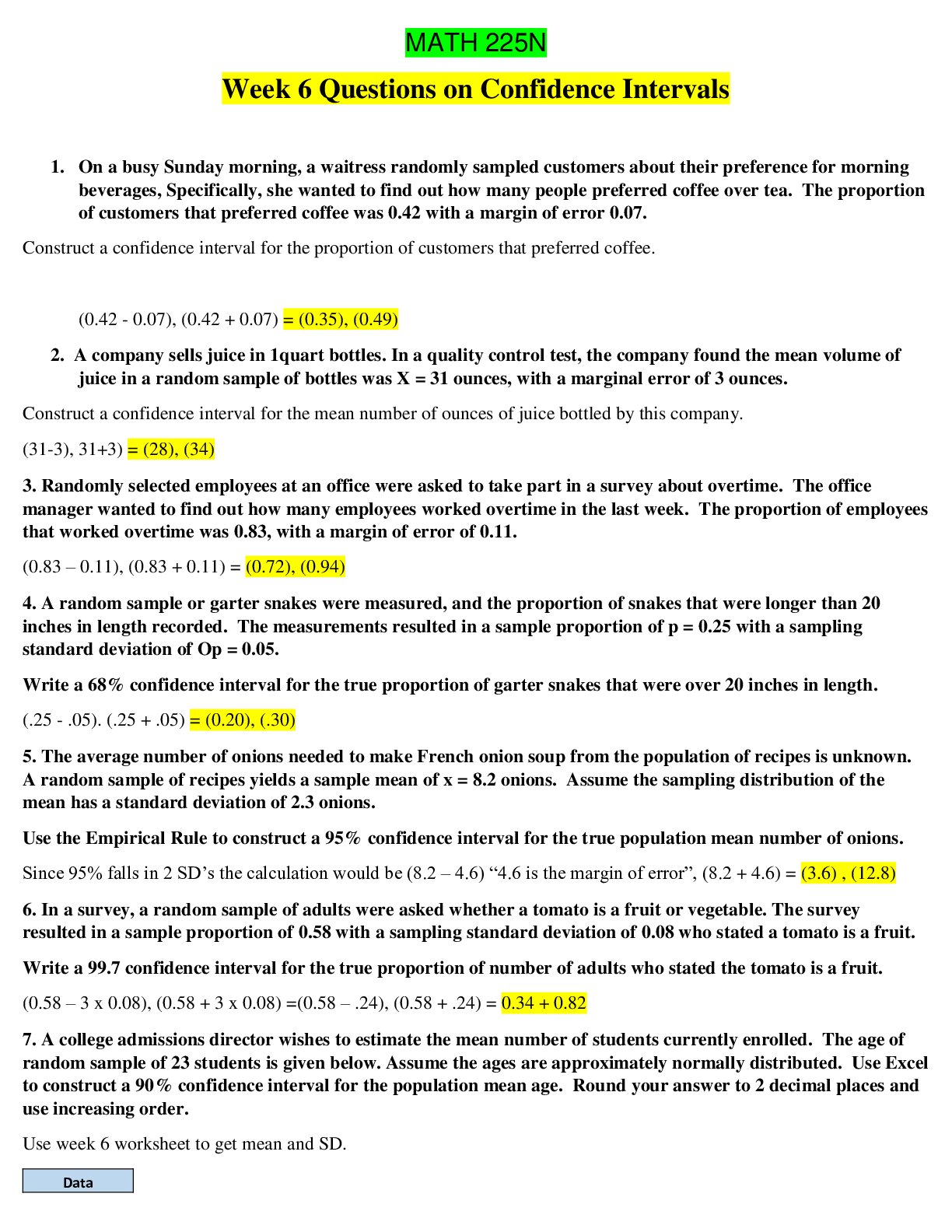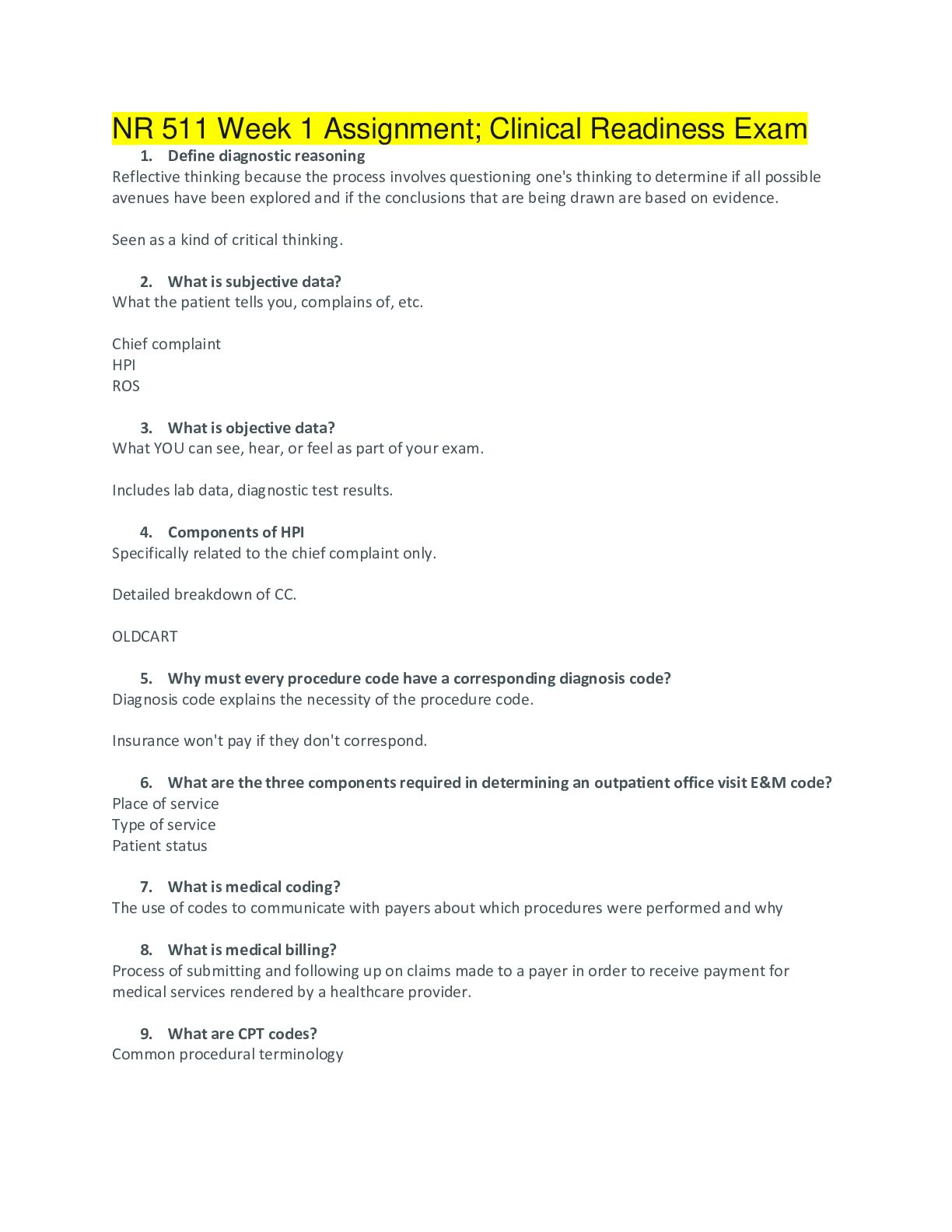*NURSING > EXAM > Obstetrician Chap 21 Nursing Management of Labor and Birth at Risk Questions and Answers with Correc (All)
Obstetrician Chap 21 Nursing Management of Labor and Birth at Risk Questions and Answers with Correct Explanations 2021
Document Content and Description Below
A woman is admitted to the labor suite with contractions every five minutes lasting one minute. She is post-term and has oligohydramnios. What does this increase the risk of during delivery? a) Cor... d compression b) Macrosomia c) Shoulder dystocia d) Fetal hydrocephalus Labor dystocia is an abnormally progression of labor. It is the most common cause of primary caesarian delivery. When is it most common for labor dystocia to occur? a) Fourth stage of labor b) Third stage of labor c) First stage of labor d) Second stage of labor A laboring patient has been pushing without delivering the fetal shoulders. The physician determines the fetus is experiencing shoulder dystocia. What intervention can the nurse assist with to help with the delivery? a) Positioning the woman prone b) Fundal pressure c) Lamaze position d) McRobert's maneuver A woman is going to have labor induced with oxytocin. Which statement below reflects the induction technique you anticipate her primary-care provider will order? a) Administer oxytocin diluted in the main intravenous fluid. b) Administer Pitocin in two divided intramuscular sites. c) Administer Pitocin in a 20 cc bolus of saline. d) Administer oxytocin diluted as a "piggyback" infusion. A client in week 38 of her pregnancy has an ultrasound performed at a routine office visit and learns that her fetus has not moved out of a breech position. Which intervention does the nurse anticipate for this client? a) Vacuum extraction b) External cephalic version c) Trial labor d) Forceps birth A patient is 23 weeks gestation and was admitted for induction and delivery after noting the infant was an intrauterine fetal death. The patient had fallen 3 days prior to the diagnosis and landed on her side. What is the most likely attributable cause to the fetal death? a) Placental abruption b) Preeclampsia c) Premature rupture of membranes d) Genetic abnormality In vasa previa, the umbilical vessels of a velamentous cord insertion cross the cervical os and therefore deliver before the fetus. a) False b) True a) Pre-term pregnancy b) Gestational diabetes c) Maternal rickets d) Small body size of mother A multipara presents to the hospital after 2 hours of labor. The fetus is presenting in transverse lie. You notify the physician and take what action? a) Apply pressure to the woman's lower back with a fisted hand. b) Include a set of piper forceps when you prep the table. c) Assist with Nitrazine and fern tests. d) Prepare to assist with external version or prep for a cesarean section delivery. After teaching a class about various methods for cervical ripening, the instructor determines that the teaching was successful when the class identifies which of the following as a surgical method? a) Laminaria b) Amniotomy c) Breast stimulation d) Prostaglandin A nursing instructor is teaching students about fetal presentations during delivery. The most common cause for increased incidence of shoulder dystocia is: a) increased number of overall pregnancies b) poor quality of prenatal care c) increasing birth weight d) longer lengths of labor At the hospital, a client is attached to the fetal monitor for uterine rupture. The nurse would assess for which pattern indicating change in the uterus impacting the fetus? a) Early decelerations. b) Variable decelerations. c) Mild decelerations. d) Late decelerations. A client's membranes have just ruptured. Her fetus is presenting breech. Which of the following should the nurse do immediately to rule out prolapse of the umbilical cord in this client? a) Administer amnioinfusion b) Assess fetal heart sounds c) Administer oxygen at 10 L/min by face mask d) Place the woman in Trendelenburg position Shoulder dystocia is a true medical emergency that can cause fetal demise because the baby cannot be delivered. Stuck in the birth canal, the infant cannot take its first breath. What is the first maneuver tried to deliver an infant with shoulder dystocia? a) McRonald Maneuver b) McRoberts maneuver c) McGeorge maneuver d) McDonald maneuver After an hour of oxytocin therapy, a woman in labor states she feels dizzy and nauseated. Your best action would be to a) administer oral orange juice for added potassium. b) assess her vaginally for full dilation. c) assess the rate of flow of the oxytocin infusion. d) instruct her to breathe in and out rapidly. Which intervention would be most appropriate for the woman experiencing dystocia related to problems involving the psyche? a) Preparing the woman for an amniotomy b) Administering oxytocin c) Encouraging the woman to assume a hands-and-knees position d) Providing a comfortable environment with dim lighting A nursing student has learned that precipitous labor is when the uterus contracts so frequently and with such intensity that a very rapid birth will take place. This means the labor will be completed in which span of time? a) < 8 hours b) < 4 hours c) < 3 hours d) < 5 hours At 31 weeks' gestation, a 37-year-old woman who has a history of preterm birth reports cramps, vaginal pain, and low, dull backache accompanied by vaginal discharge and bleeding. Her cervix is 2.1 cm long; she has fetal fibronectin in her cervical secretions, and her cervix is dilated 3 to 4 cm. For what do you prepare her? a) An emergency cesarean section b) Bed rest and hydration at home c) Hospitalization, tocolytic therapy, and IM corticosteroids d) Careful monitoring of fetal kick counts A nurse is assessing a full-term patient in labor and determines the fetus is occiput posterior. The patient states that all her discomfort is in her lower back. What intervention can the nurse provide that will help alleviate this discomfort? a) Use a fist to apply counter pressure to the lower back. b) Apply a warm washcloth to the lower back. c) Have the physician administer a pudendal block. d) Place the patient supine with the head of bed elevated 30 degrees. A client in the first stage of labor is diagnosed with dystocia involving the powers of labor. Which of the following would the nurse identify as the problem? a) Contractions are insufficient to cause fetus descent b) Uterine contractions are too weak or uncoordinated c) Pelvis is either android type or platypelloid type d) Fetus is in a different position or presentation A nursing student correctly identifies the most desirable position to promote an easy delivery as which of the following? a) occiput anterior b) face and brow c) shoulder dystocia d) breech Immediately after delivering a full-term infant, a patient develops dyspnea and cyanosis. Her blood pressure decreases to 60/40 mm Hg, and she becomes unresponsive. What does the nurse suspect is happening with this patient? a) Congestive heart failure b) Amniotic fluid embolism c) Placental separation d) Aspiration You assess that the fetus of a woman is in an occiput posterior position. Which of the following identifies the way you would expect her labor to differ from others? a) Need to have the baby manually rotated. b) Necessity for vacuum extraction for delivery. c) Shorter dilatational stage of labor. d) Experience of additional back pain. The nurse would prepare a client for amnioinfusion when which of the following occurs? a) Fetal presenting part fails to rotate fully and descend in the pelvis b) Maternal pushing is compromised due to anesthesia c) The fetus shows non-reassuring fetal heart rate patterns d) Severe variable decelerations are due to cord compression Why is it important for the nurse to thoroughly assess maternal bladder and bowel status during labor? a) A full bladder or rectum can impede fetal descent. b) If the woman has a full bladder, labor may be uncomfortable for her. c) A full rectum can cause diarrhea. d) If the woman's bladder is distended, it may rupture. A pregnant woman has just found out that she is having twin girls. She asks the nurse the difference between fraternal and identical twins. The nurse explains that with one set of twins there is fertilization of two ova, and with the other set one fertilized ovum splits. What type of twins result from the split ovum? a) both types can result from the split ovum b) fraternal c) neither type results from a split ovum d) identical A placenta succenturiate is a placenta in which the cord is inserted marginally rather than centrally. a) False b) True The experienced labor and delivery nurse knows to evaluate progress in active labor by using which simple rule? a) 1/2 cm/hour for cervical dilation b) 1 cm/hour for cervical dilation c) 2 cm/hour for cervical dilation d) 1/4 cm/hour for cervical dilation [Show More]
Last updated: 1 year ago
Preview 1 out of 29 pages

Buy this document to get the full access instantly
Instant Download Access after purchase
Add to cartInstant download
We Accept:

Reviews( 0 )
$15.00
Document information
Connected school, study & course
About the document
Uploaded On
Nov 09, 2021
Number of pages
29
Written in
Additional information
This document has been written for:
Uploaded
Nov 09, 2021
Downloads
0
Views
29





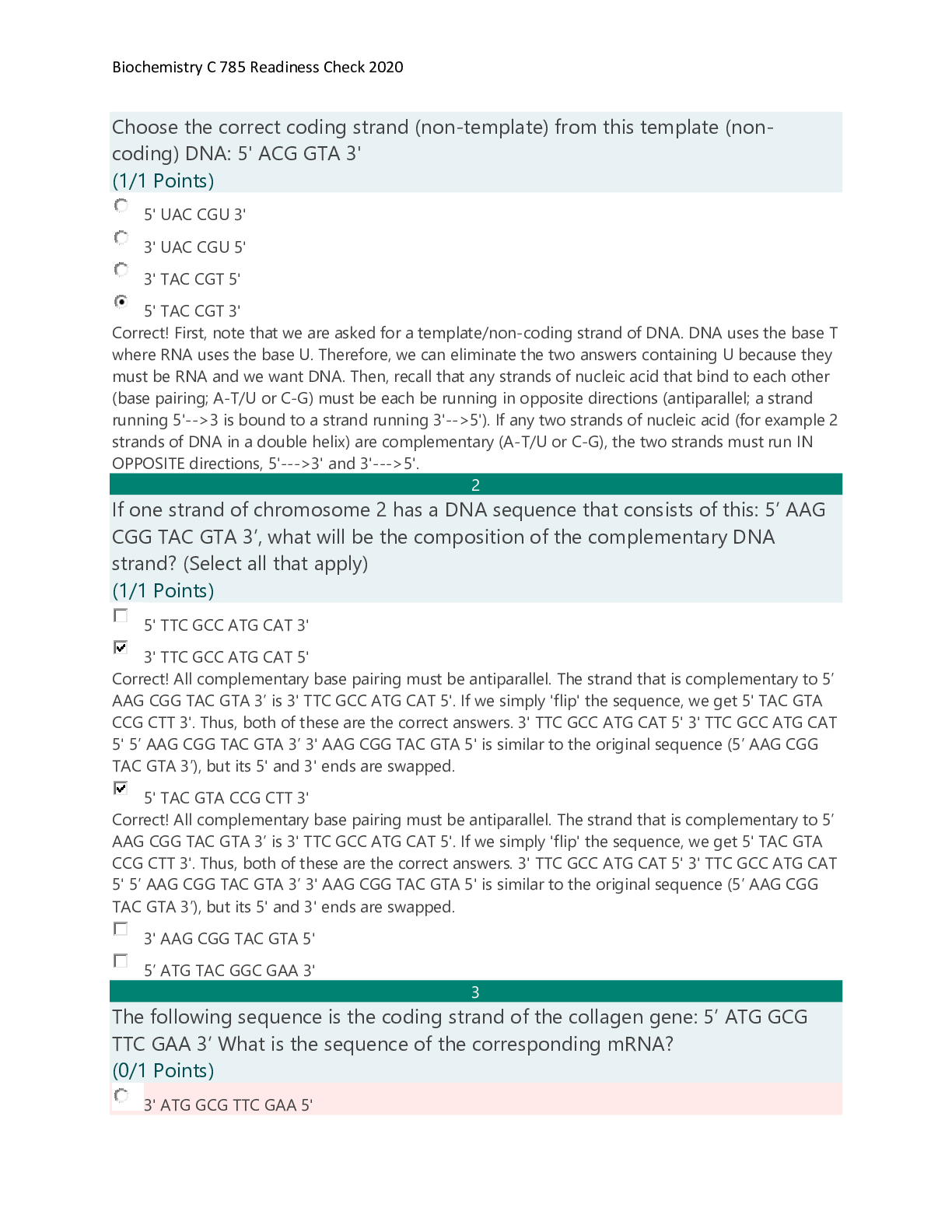
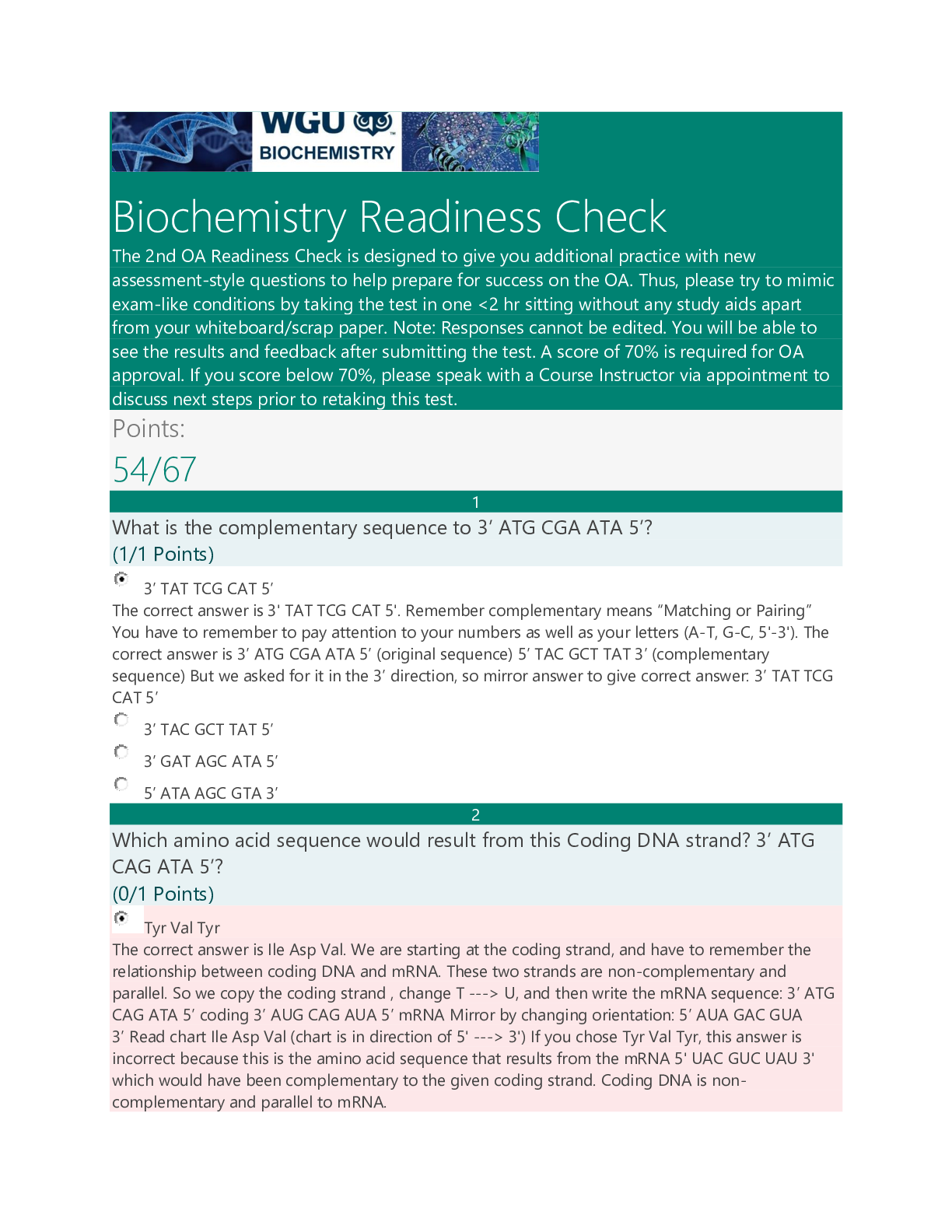


.png)

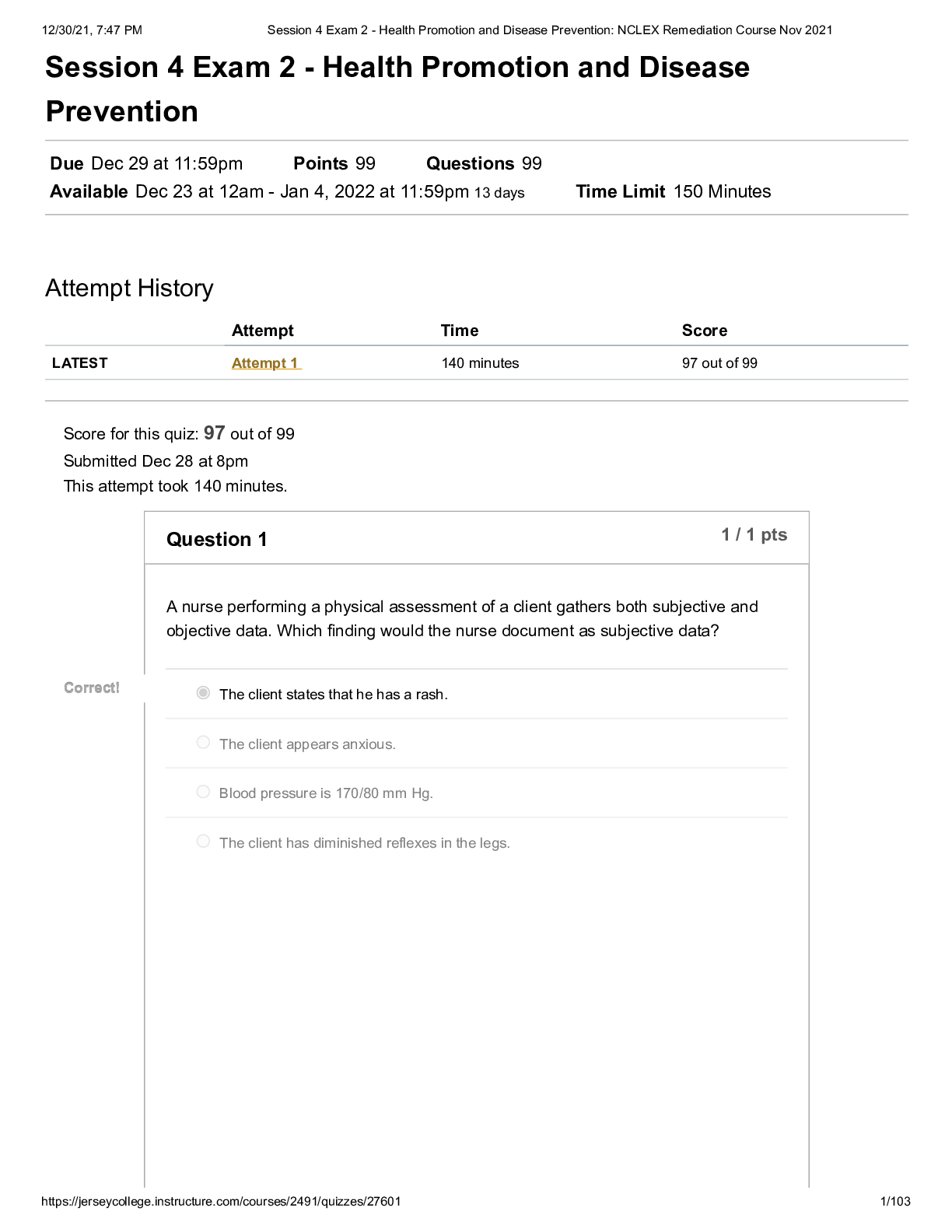
 ORGMED ORGANIC PHARMACEUTICAL PHARMACY.png)





